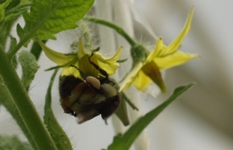Pollination of Greenhouse Tomatoes by the Mexican bumblebee Bombus ephippiatus (Hymenoptera: Apidae)
DOI:
https://doi.org/10.26786/1920-7603(2012)1Abstract
The Mexican native bumblebee Bombus ephippiatus Say was evaluated as a potential pollinator of greenhouse tomatoes (Solanum lycopersicon L.). The experiments were performed at San Andrés Cholula, Puebla, Mexico, from June to December 2004 in two 1 000 m2 greenhouses planted with tomatoes of the cultivar Mallory (Hazera ®). For the experiments, we used two colonies of Bombus ephippiatus, reared in the laboratory from queens captured in the field. Four treatments were applied to 20 study plants: pollination by bumble bees, manual pollination, pollination by mechanical vibration and no pollination (bagged flowers, no vibration). We measured percentage of flowers visited by bumble bees, number of seeds per fruit, maturing time, sugar content, fruit weight and fruit shape. All available flowers were visited by bumblebees, as measured by the degree of anther cone bruising. The number of seeds per fruit was higher for bumble bee-pollinated plants as compared with plants pollinated mechanically or not pollinated and was not significantly different between hand-pollinated and bumble bee-pollinated plants. Maturation time was significantly longer and sugar content, fresh weight and seed count were significantly higher for bumblebee pollinated flowers than for flowers pollinated manually or with no supplemental pollination, but did not differ with flowers pollinated mechanically.

Downloads
Published
How to Cite
Issue
Section
License
Copyright (c) 2012 Carlos Hernan Vergara, Paula Fonseca-Buendía

This work is licensed under a Creative Commons Attribution 4.0 International License.
JPE is an open access journal which means that all content is freely available without charge to the user or his/her institution.
Authors who publish with this journal agree to the following terms:
1) Authors retain copyright and grant the journal right of first publication with the work simultaneously licensed under a Creative Commons Attribution License that allows others to share the work with an acknowledgement of the work's authorship and initial publication in this journal.
2) Authors are able to enter into separate, additional contractual arrangements for the non-exclusive distribution of the journal's published version of the work (e.g., post it to an institutional repository or publish it in a book), with an acknowledgement of its initial publication in this journal.
3) Authors are permitted and encouraged to post their work online (e.g., in institutional repositories or on their website) prior to and during the submission process, as it can lead to productive exchanges, as well as earlier and greater citation of published work (See The Effect of Open Access).
To assure a broader targeted audience, content will be included into databases (such as EBSCO) and directories (such as DOAJ).











